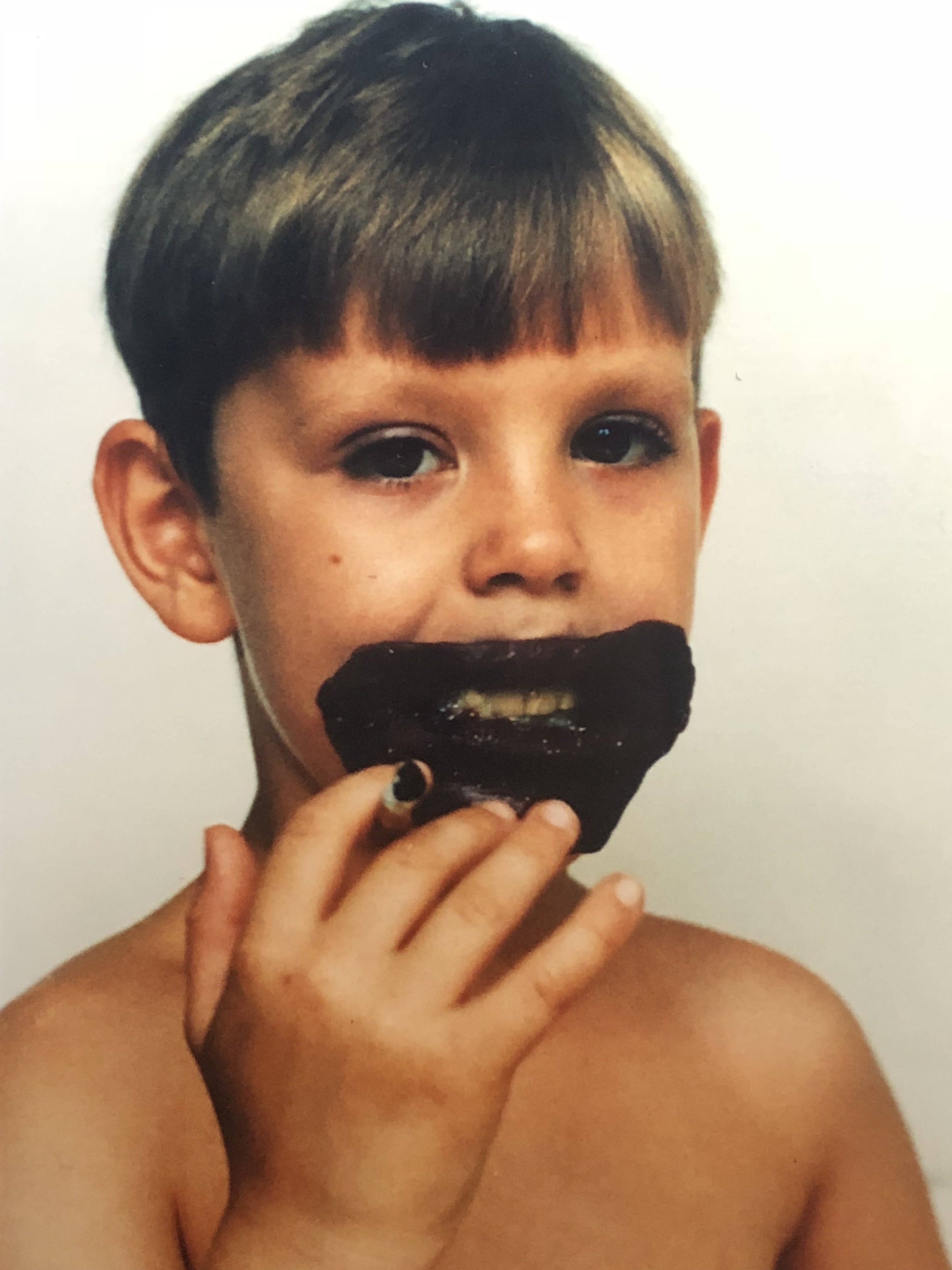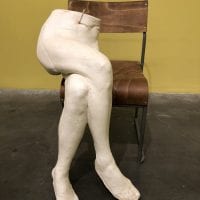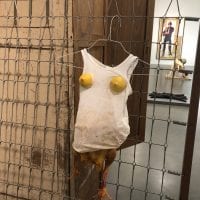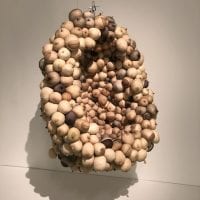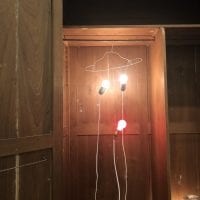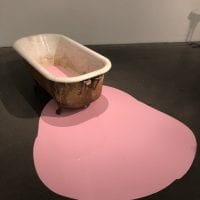The installation that stuck with me the most was Maria Simnett’s film Blood in My Milk, specifically the portion which I later found out was titled The Udder. Though some of it was a bit difficult to understand, the overall idea was very clear. The main character, the little blond girl named Isabel carries the audience through a disturbing tale. I think it’s disturbing for several reasons. First, it’s physically sickening to be face to face with the reality of the modern dairy industry. Seeing an udder milked by a mechanical robot is unsettling, as well as seeing meat sliced open. It’s graphic, and since there are huge screen every direction, you can’t look away. I found myself closing my eyes during some parts, but the sounds that accompany it never allow you to actually escape. I won’t lie, I have been avoiding milk at all costs since seeing the film. The second aspect of it is a riveting as it is disturbing, and is disturbing in a much more nuanced way. Isabel is constantly chastised by her mother, and doesn’t have a moment to relax without her mother fixing her appearance. While berating her about her looks, she throws in life lessons that sound ridiculous but are very prevalent in most young girl’s childhoods. Isabel is told she’s too beautiful to play outside, and is kept separate from her brothers for most of the film besides a few moments. A lot of the lessons are told in reference to keeping the udder clean and free of infection but are metaphorical for the lessons young girls are taught about their bodies and being chaste. Isabel is taught that long hair is “too likely to trap dirt and increase the risk of pathogens,” so it should always be clipped, which can be compared to the beauty industry’s profiting off of women being convinced they must shave off all their hair to be attractive. She is taught that chastity is the only thing that will keep her safe, and the only thing that protects from contamination. This echoes back to the fact that she is kept indoors in order to protect her from said contamination, which I interpreted as sexual freedom. If women aren’t chaste, they’re criticized, shamed, and made to think that they are unclean. It’s a very old fashioned concept but has somehow remained very strong in our culture. This story is told almost like a nursery rhyme, with some rhyming sentences and songs that sound childlike but are about graphic topics. Isabel’s song about Mastitis is especially shocking because it’s a young girl singing about such a horrible thing, but the ideas of purity and beauty are deeply rooted in childhood so I think it really helped get the point across. It also reminded me of some Disney films that have a common theme of locking women away for various reasons, often by a male figure like their father, like Beauty and the Beast, Cinderella, Sleeping Beauty, and the Little Mermaid.
I was really interested by the comparisons between the cows on the farm, and Isabel. Ultimately, the film not only looks at the policing of women’s bodies, but also the control that is obtained from this policing. Isabel is very young but is already a shell of a person, burdened with constantly protecting herself and being aware of all the dangers in the world that threaten her. She is faced with having to follow conventional beauty standards, while also being told she’s too beautiful to ever be safe. She faces an issue that is very pervasive; society wants women to look perfect, then blames our appearance when we are harmed. The mastitis is not just the infection, and not just the loss of purity from not being chaste, but to me can also represent more abstract concepts like sexual assault, and domestic abuse. Isabel can stay chaste and follow all her mother’s rules, but, as her brothers even wonder about, will it be enough to keep her safe in a world that targets women? She is controlled by the expectation to look beautiful but remain chaste, and controlled by the fear that if she is not, then she will be infected. What resonated with me the most is that she is controlled by the idea that if she is infected, whether that means getting an STD, getting pregnant, or being assaulted, she is to blame. She is in charge of protecting herself from all of these things and if she can’t, then she will be shamed. Throughout the film her brothers are seen playing, laughing, and generally having fun while Isabel remains solemn and reserved the entire film, and I think this is really indicative of the fact that while girls are taught of the dangers they face, boys aren’t taught to help protect girls from these danger, in fact are taught quite the opposite. When boys are the cause of these dangers, it’s the girls fault for not protecting herself for following the rules she was taught. The brothers even conspire to harm their sister, saying they will ‘cut her up […] dismantle her into a million bits so that she can never be rebuilt’, which is hyperbolic but truly representative of the views of women as sexual objects, or conquests which plays back into the idea of control. Women are broken down in order to be controlled, and violence against women, while on the surface is seen as bad, is subconsciously celebrated.
The rest of the film was also interesting, and tied together well, but did not speak to me as much as The Udder. Overall I think the 3 exhibitions were really interesting together. They made me think about society’s contradicting portrayal of sexuality. It’s used to market everything, yet people are shamed when they embrace their sexuality. It’s a constant attraction and repulsion and it can be really confusing for the people who don’t fall into the normal idea of gender and sexuality. Au Naturel spanned such a wide variety of mediums and topics but was so cohesive with the use of cigarettes and eggs. And Birth Canal was terrifying to enter but really beautiful when I did, and I have studied the Venus of Willendorf and other Venus figurines so it was cool to see them morphed and distorted. I really enjoyed the exhibit. Here are some pictures of the pieces I especially liked:
